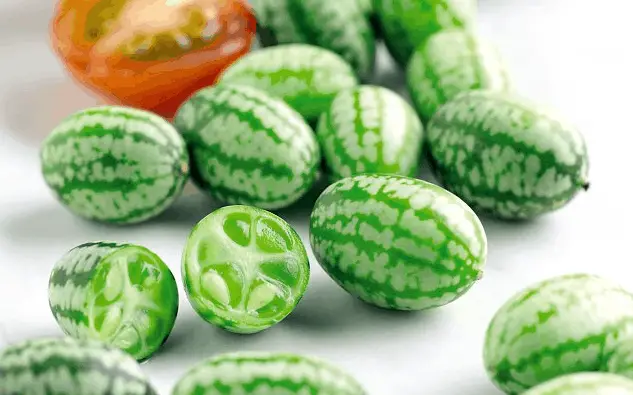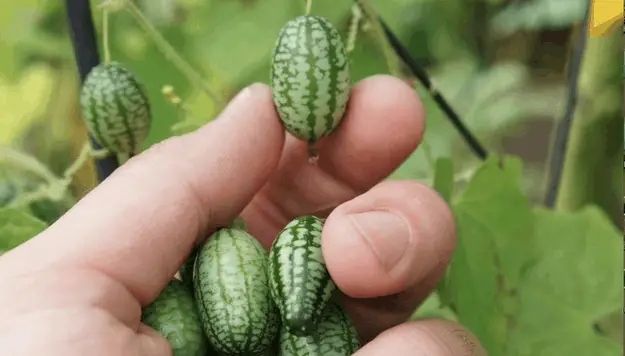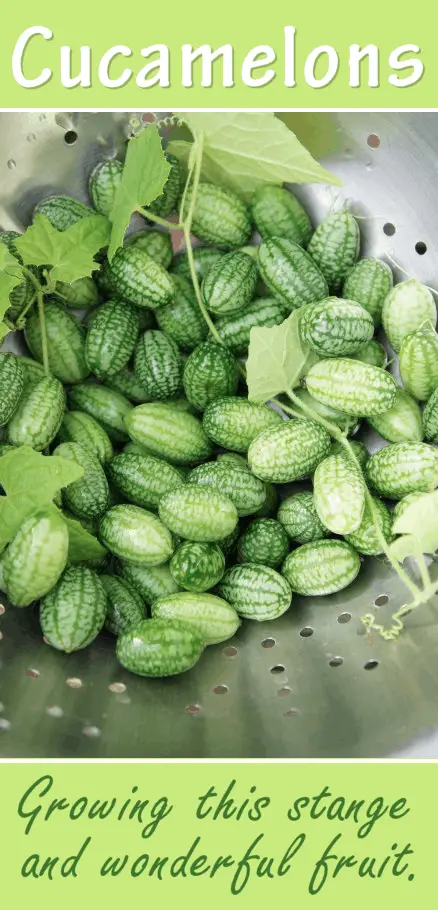Table of Contents
Have you planned what to plant in your garden this year? And are you willing to try something new?
Yes, there is a distinct plant to grow in your garden that produces delicious fruit. For example, have you heard of the cucamelon? If you haven’t, you are in for a real treat!
For those who have space and are willing to give something new a try, this plant is the perfect one. It is unique and produces edible fruit that is quite tasty.
Visitors to your garden will be thrilled to see such an amazing plant growing and will have a hundred questions to ask you. Let’s address those questions for you and anybody else who may see your cucamelon plant.
What is Cucamelon?
Cucamelon is a one-inch fruit and is the cutest one you can have in your garden. There’s no doubt why they are called mouse melons. Scientifically speaking, cucamelon is neither a cucumber nor a melon. However, it’s classified into a large cucumber family.
The botanical name of cucamelon is Melothria Scabra belonging to the Cucurbitaceae family. They are sown during the spring, and yellow flowers are visible during late spring or arriving summer. Cucamelon has white content but is crunchy with a tangy flavor.
The fruit is a cucumber that looks like a miniature watermelon. You are probably familiar with a watermelon plant. In the earliest stages of melon development, it resembles tiny little watermelons.
It grows best in full sun for at least 7-8 hours, but it can tolerate some afternoon shade. Besides, the cucamelon thrives in the humus soil with a slightly high acidic pH. That’s why it’s recommended to form compost before planting cucamelons.
The cucamelon plant produces similar fruit, but the only difference is that it is ripe and ready to eat at this stage. The fruit is about the size of a grape when it is ready to be plucked from the vine. The cucamelon is also called the Mexican Sour Gherkin or Sandiita, which means little watermelon in Spanish.
What Does it Taste Like?
Surprisingly, it tastes nothing like a watermelon. It tastes like a cucumber soaked in lime juice. It has a refreshing and tangy flavor. Also, the cucamelons can be pickled, similar to a cucumber. Tip: When it’s flavored with dill and mint in the pickling process, it is delicious.
The fruit can be eaten right off the vine as well. You don’t have to peel the cucamelon like you would a cucumber. You can toss the cucamelons in a salad whole or sliced, similar to a grape tomato.
Tossing the cucamelons in a little olive oil and serving with sliced peppers is also a tasty treat. If you like a martini at night, use a cucamelon instead of an olive for your drink. You can find more ways to use the cucamelons once you get that first taste.
Cucamelon’s Nutritional Contents
Cucamelon is a superfood that is filled with nutrients along with fewer calories. Thus, it’s a healthy food option for the ones who are dieting.
Cucamelon’s nutritional contents are vitamin K, vitamin E, vitamin C, potassium, fiber, and strong antioxidants like lycopene and beta-carotene.
Ways to Eat Cucamelons
Cucamelon can be eaten raw and in dishes having tangy and sour flavors. Generally, they are added to salsas and salads. Not to mention, it can also be pickled like cucumbers. For a salad, it can be mixed with leafy greens, sweet pepper, cherry tomatoes, and herbs like basil parsley.
To store them as a pickle, put them in a jar with apple cider vinegar, salt, and water. For lip-licking flavors, consider adding fresh dill, chili peppers, and mustard seeds. In a salsa, cucamelons can replace tomatoes making it less acidic and tastier.
Is Cucamelon GMO?
It’s difficult to say for sure, but according to several articles on the web, the cucamelons are not GMO. They are actually native to Central America, where they are traditional.
They are served as a delicacy in the region. The fruits were part of the Aztec community’s diet but have remained a secret until recently. Besides, they are not a hybrid.
How to Grow the Cucamelons
Firstly, you’ll need the seeds. They’ll not be found at The Home Depot or your local co-op. You will need to look online. They are available at the same price as other seeds you would buy from online retailers. Expect to get around 30 seeds in a packet, which is fairly enough.
Cucamelons have a seed to maturity time of about 80 days, which makes them an ideal crop even for those in cool climates.
They are fast growers as you will see full-grown plants in only two months. The cucamelons can be grown in a variety of ways. They are not invasive and won’t dominate your garden if you decide to go that way.
- Barrels
- Pots
- Bags
- Direct seed in the garden
The cucamelon plant is a vining plant and will need a trellis. However, the plants do not require a lot of room to grow, making them ideal in a container. Moreover, you could plant several plants closely to share a trellis.
Plant seedlings or seeds about 6 inches apart. The plants will grow around 3 to 5 feet high, so ensure your trellis is tall enough to support them. You could use a few bamboo poles similar to what you would use with pea plants. The plants send out little shoots to wrap around the bamboo for support.
However, you can use biodegradable pots for their plantation as it will not hinder root growth. Also, it’ll be super easy to transplant to your garden.
The plants are not as sensitive as a cucumber and can be planted directly outdoors once the chance of frost is gone. However, they do need plenty of water.
There are no special pruning techniques involved. They are easy to plant and ignore until you are ready to pick the fruit. Of course, you’ll need to remember to water them.
It is time to harvest when the cucamelons are still firm and the size of a grape. The plants can be prolific. If you are not planning on preserving them by pickling, be cautious with how many seeds you put in the ground.
Of course, you will probably not have a problem giving your cucamelons to your friends and neighbors.
After the first season, you will discover your cucamelon plants produce very long, tuberous roots similar to a dahlia or iris.
You can dig up these roots and store them in a cool, dry place over the winter. Next planting season, put the tubers in the ground. You will get an earlier crop with twice as much fruit.
If you have been looking for something new to plant in your garden, cucamelon is an excellent choice. Saving the tubers your plants grow can actually help you add a little cash to your wallet.
Because the seeds are not widely available, you could sell the tubers in your local area to interested buyers. You will still have enough to plant a new crop and produce even more tubers for the following year.
Where To Get Them
Want to grow these little curiosities? You can get seeds here for pretty cheap.



